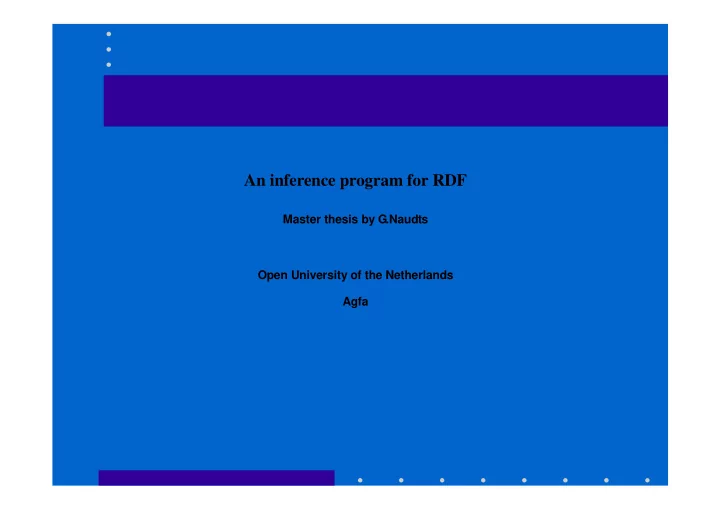

An inference program for RDF Master thesis by G.Naudts Open University of the Netherlands Agfa
Standards
Case study 3
Research questions 1) Haskell spec of RDF inference program 2) Soundness and completeness 3) What logics? 4) optimization 5) inconsistency
RDF / DEMO • Database: Regels: child(X, Y), child(Y, Z) :> grandparent(Z, X). grandparent(Z, X), gender(Z, female) :> grandmother(Z, X). Feiten: child(christine, elza). child(wim, christine). gender(elza, female). • Query: grandmother(Z, X).
WWW aspects • subqueries • closed / open world • verifiability / trust -> origin • inconsistencies
Implementation
Inference engine for RDF • Two versions: 1) Classic structure, well tested 2) Better adapted to the semantic web
Search Tree / DEMO
Finite State Machine
Open World Consequences • An open set has no borders • An (open?) set has no complement • An element belongs to set A or set B or not known (no law of excluded middle) • There is no universal quantifier for open sets
Research questions 1) Haskell spec of RDF inference program 2) Soundness and completeness 3) What logics? 4) optimization 5) inconsistency
Graph syntax of RDF
Graph theory
Research questions 1) Haskell spec of RDF inference program 2) Soundness and completeness 3) What logics? 4) optimization 5) inconsistency
Logic • Constructive logic cfr. Escher - architect • Each triple in a proof must exist • Verifiability
RDF Graph • URI:http://www.daml.org/2001/01/gedcom/ gedcom# • gd:sun(def:Frank,def:Christine).
Research questions 1) Haskell spec of RDF inference program 2) Soundness and completeness 3) What logics? 4) optimization 5) inconsistency
Optimization / DEMO • Question: grandmother(Z, X) • Solution: fact -> rule -> …. -> rule -> solution = grandmother(elza,wim) • Specific rule: t1, t2, t3, .., tn --> grandmother(Z,X) • child(X,Y), child(Y,Z), gender(Z, female):> grandmother(Z,X). • Other
Research questions 1) Haskell spec of RDF inference program 2) Soundness and completeness 3) What logics? 4) optimization 5) inconsistency
Inconsistencies • Importance of selected logic • No Ex Contradictione Quodlibet • Trust system • Wait and see
Research questions 1) Haskell spec of RDF inference program 2) Soundness and completeness 3) What logics? 4) optimization 5) inconsistency
Case study 26
Questions?
DEMO 1 start Enter command (? for help): ? h : help ? : help q : exit s : perform a single inference step g : go; stop working interactively m : menu e : execute menu item qe : enter a query p : print the graphs
DEMO 2 m&&&& You entered:m&&&&& Please, try again. m Type the command e.g. "e pro11." pro11 authentication example pro21 flight simulation pro31 subClassOf example pro41 demo example pro51 gedcom Enter "e item".
DEMO 3 Enter "e item". e pro41 RDFProlog version 2.0 Reading files ... Enter command (? for help): s step: goal: grandmother(_1?Z,_1?X)./10 goallist: grandmother(_1?Z,_1?X)./10 substitution: [] history:
DEMO 4 s step: goal: grandparent(1$_$_2?Z,1$_$_2?X)./2 goallist: grandparent(1$_$_2?Z,1$_$_2?X)./2 gender(1$_$_2?Z,female)./2 substitution: [(_1?Z,1$_$_2?Z)(_1?X,1$_$_2?X)] history: (grandparent(1$_$_2?Z,1$_$_2?X),gender(1$_$_2?Z,female) :> grandmother(1$_$_2?Z,1$_$_2?X)./2,grandmother(_1?Z,_1?X)./10)
DEMO 5 s step: goal: child(2$_$_1?X,2$_$_1?Y)./2 goallist: child(2$_$_1?X,2$_$_1?Y)./2 child(2$_$_1?Y,2$_$_1?Z)./2 gender(1$_$_2?Z,female)./2 substitution: [(_1?Z,1$_$_2?Z)(_1?X,1$_$_2?X)(1$_$_2?Z,2$_$_1?Z)(1$_$_2?X,2$_$_1?X)] history: (child(2$_$_1?X,2$_$_1?Y),child(2$_$_1?Y,2$_$_1?Z) :> grandparent(2$_$_1?Z,2$_$_1?X)./2,grandparent(1$_$_2?Z,1$_$_2?X)./2) (grandparent(1$_$_2?Z,1$_$_2?X),gender(1$_$_2?Z,female) :> grandmother(1$_$_2?Z,1$_$_2?X)./2,grandmother(_1?Z,_1?X)./10)
DEMO 6 s step: goal: /0 goallist: /0 child(2$_$_1?Y,2$_$_1?Z)./2 gender(1$_$_2?Z,female)./2 substitution: [(_1?Z,1$_$_2?Z)(_1?X,1$_$_2?X)(1$_$_2?Z,2$_$_1?Z)(1$_$_2?X,2$_$_1?X)(2$_$_1?X,christine)(2 $_$_1?Y,elza)] history: (child(christine,elza)./2,child(2$_$_1?X,2$_$_1?Y)./2) (child(2$_$_1?X,2$_$_1?Y),child(2$_$_1?Y,2$_$_1?Z) :> grandparent(2$_$_1?Z,2$_$_1?X)./2,grandparent(1$_$_2?Z,1$_$_2?X)./2) (grandparent(1$_$_2?Z,1$_$_2?X),gender(1$_$_2?Z,female) :> grandmother(1$_$_2?Z,1$_$_2?X)./2,grandmother(_1?Z,_1?X)./10)
DEMO 7 s step: goal: child(2$_$_1?Y,2$_$_1?Z)./2 goallist: child(2$_$_1?Y,2$_$_1?Z)./2 gender(1$_$_2?Z,female)./2 substitution: [(_1?Z,1$_$_2?Z)(_1?X,1$_$_2?X)(1$_$_2?Z,2$_$_1?Z)(1$_$_2?X,2$_$_1?X)(2$_$_1?X,christine)(2 $_$_1?Y,elza)] history: (child(christine,elza)./2,child(2$_$_1?X,2$_$_1?Y)./2) (child(2$_$_1?X,2$_$_1?Y),child(2$_$_1?Y,2$_$_1?Z) :> grandparent(2$_$_1?Z,2$_$_1?X)./2,grandparent(1$_$_2?Z,1$_$_2?X)./2) (grandparent(1$_$_2?Z,1$_$_2?X),gender(1$_$_2?Z,female) :> grandmother(1$_$_2?Z,1$_$_2?X)./2,grandmother(_1?Z,_1?X)./10)
DEMO 8 s **** No unification; path aborted. **** s **** Backtrack done. **** s
DEMO 9 s step: goal: /0 goallist: /0 child(2$_$_1?Y,2$_$_1?Z)./2 gender(1$_$_2?Z,female)./2 substitution: [(_1?Z,1$_$_2?Z)(_1?X,1$_$_2?X)(1$_$_2?Z,2$_$_1?Z)(1$_$_2?X,2$_$_1?X)(2$_$_1?X,wim)(2$_$_ 1?Y,christine)] history: (child(wim,christine)./2,child(2$_$_1?X,2$_$_1?Y)./2) (child(2$_$_1?X,2$_$_1?Y),child(2$_$_1?Y,2$_$_1?Z) :> grandparent(2$_$_1?Z,2$_$_1?X)./2,grandparent(1$_$_2?Z,1$_$_2?X)./2) (grandparent(1$_$_2?Z,1$_$_2?X),gender(1$_$_2?Z,female) :> grandmother(1$_$_2?Z,1$_$_2?X)./2,grandmother(_1?Z,_1?X)./10)
DEMO 10 s step: goal: child(2$_$_1?Y,2$_$_1?Z)./2 goallist: child(2$_$_1?Y,2$_$_1?Z)./2 gender(1$_$_2?Z,female)./2 substitution: [(_1?Z,1$_$_2?Z)(_1?X,1$_$_2?X)(1$_$_2?Z,2$_$_1?Z)(1$_$_2?X,2$_$_1?X)(2$_$_1?X,wim)(2$_$_ 1?Y,christine)] history: (child(wim,christine)./2,child(2$_$_1?X,2$_$_1?Y)./2) (child(2$_$_1?X,2$_$_1?Y),child(2$_$_1?Y,2$_$_1?Z) :> grandparent(2$_$_1?Z,2$_$_1?X)./2,grandparent(1$_$_2?Z,1$_$_2?X)./2) (grandparent(1$_$_2?Z,1$_$_2?X),gender(1$_$_2?Z,female) :> grandmother(1$_$_2?Z,1$_$_2?X)./2,grandmother(_1?Z,_1?X)./10)
DEMO 11 s step: goal: /0 goallist: /0 gender(1$_$_2?Z,female)./2 substitution: [(_1?Z,1$_$_2?Z)(_1?X,1$_$_2?X)(1$_$_2?Z,2$_$_1?Z)(1$_$_2?X,2$_$_1?X)(2$_$_1?X,wim)(2$_$_ 1?Y,christine)(2$_$_1?Z,elza)] history: (child(christine,elza)./2,child(christine,2$_$_1?Z)./2) (child(wim,christine)./2,child(2$_$_1?X,2$_$_1?Y)./2) (child(2$_$_1?X,2$_$_1?Y),child(2$_$_1?Y,2$_$_1?Z) :> grandparent(2$_$_1?Z,2$_$_1?X)./2,grandparent(1$_$_2?Z,1$_$_2?X)./2) (grandparent(1$_$_2?Z,1$_$_2?X),gender(1$_$_2?Z,female) :> grandmother(1$_$_2?Z,1$_$_2?X)./2,grandmother(_1?Z,_1?X)./10)
DEMO 12 s step: goal: gender(1$_$_2?Z,female)./2 goallist: gender(1$_$_2?Z,female)./2 substitution: [(_1?Z,1$_$_2?Z)(_1?X,1$_$_2?X)(1$_$_2?Z,2$_$_1?Z)(1$_$_2?X,2$_$_1?X)(2$_$_1?X,wim)(2$_$_ 1?Y,christine)(2$_$_1?Z,elza)] history: (child(christine,elza)./2,child(christine,2$_$_1?Z)./2) (child(wim,christine)./2,child(2$_$_1?X,2$_$_1?Y)./2) (child(2$_$_1?X,2$_$_1?Y),child(2$_$_1?Y,2$_$_1?Z) :> grandparent(2$_$_1?Z,2$_$_1?X)./2,grandparent(1$_$_2?Z,1$_$_2?X)./2) (grandparent(1$_$_2?Z,1$_$_2?X),gender(1$_$_2?Z,female) :> grandmother(1$_$_2?Z,1$_$_2?X)./2,grandmother(_1?Z,_1?X)./10)
DEMO 13 s step: goal: /0 goallist: /0 substitution: [(_1?Z,1$_$_2?Z)(_1?X,1$_$_2?X)(1$_$_2?Z,2$_$_1?Z)(1$_$_2?X,2$_$_1?X)(2$_$_1?X,wim)(2$_$_ 1?Y,christine)(2$_$_1?Z,elza)] history: (gender(elza,female)./2,gender(elza,female)./2) (child(christine,elza)./2,child(christine,2$_$_1?Z)./2) (child(wim,christine)./2,child(2$_$_1?X,2$_$_1?Y)./2) (child(2$_$_1?X,2$_$_1?Y),child(2$_$_1?Y,2$_$_1?Z) :> grandparent(2$_$_1?Z,2$_$_1?X)./2,grandparent(1$_$_2?Z,1$_$_2?X)./2) (grandparent(1$_$_2?Z,1$_$_2?X),gender(1$_$_2?Z,female) :> grandmother(1$_$_2?Z,1$_$_2?X)./2,grandmother(_1?Z,_1?X)./10)
DEMO 14 solution: Solution: Substitution: [(_1?Z,1$_$_2?Z)(_1?X,1$_$_2?X)(1$_$_2?Z,2$_$_1?Z)(1$_$_2?X,2$_$_1?X)(2$_$_1?X,wim)(2$_$_ 1?Y,christine)(2$_$_1?Z,elza)] Proof: (gender(elza,female)./2,gender(elza,female)./2) (child(christine,elza)./2,child(christine,elza)./2) (child(wim,christine)./2,child(wim,christine)./2) (child(wim,christine),child(christine,elza) :> grandparent(elza,wim)./2,grandparent(elza,wim)./2) (grandparent(elza,wim),gender(elza,female) :> grandmother(elza,wim)./2,grandmother(elza,wim)./10) General rule: "gender(X2,female),child(X1,X2),child(X3,X1) :> grandmother(X2,X3)."
Variable numbering 1 Enter "e item". e pro41 RDFProlog version 2.0 Reading files ... Enter command (? for help): s step: goal: grandmother(_1?Z,_1?X)./10 goallist: grandmother(_1?Z,_1?X)./10 substitution: [] history:
Variable numbering 2 s step: goal: grandparent(1$_$_2?Z,1$_$_2?X)./2 goallist: grandparent(1$_$_2?Z,1$_$_2?X)./2 gender(1$_$_2?Z,female)./2 substitution: [(_1?Z,1$_$_2?Z)(_1?X,1$_$_2?X)] history: (grandparent(1$_$_2?Z,1$_$_2?X),gender(1$_$_2?Z,female) :> grandmother(1$_$_2?Z,1$_$_2?X)./2,grandmother(_1?Z,_1?X)./10)
Recommend
More recommend